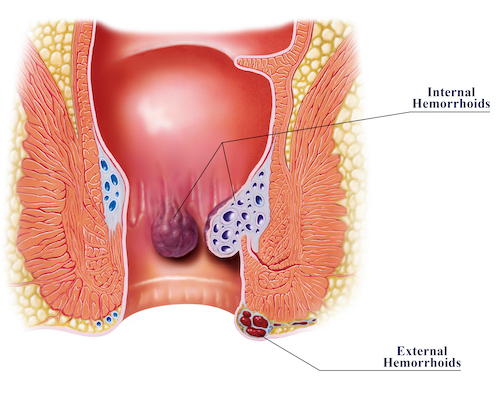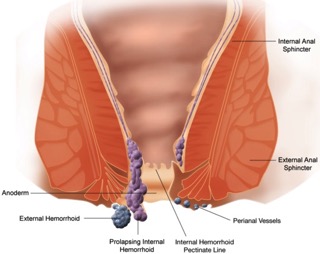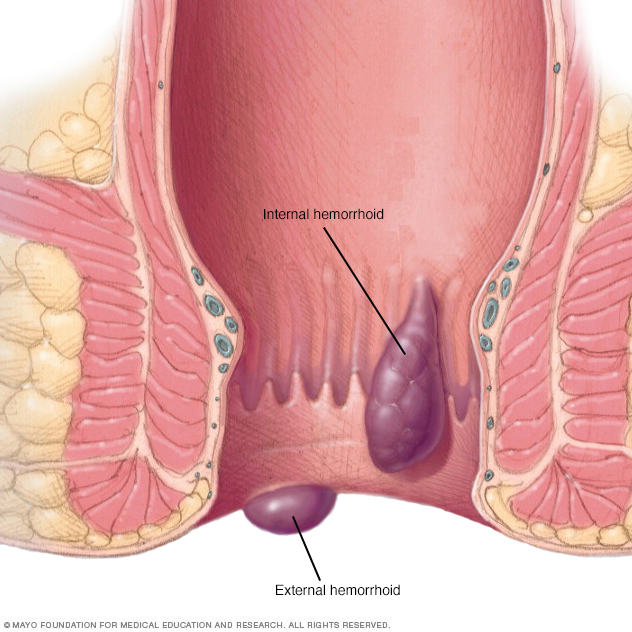As an Amazon Associate I earn from qualifying purchases.
Introduction
If you suffer from hemorrhoids, you’re not alone. This common condition affects millions of adults worldwide and can cause discomfort, bleeding, and pain during bowel movements. But what are hemorrhoids exactly, and what causes them? In this post, we’ll dive deep into the roots of hemorrhoids and explore the factors that contribute to their development.
What are hemorrhoids?
Hemorrhoids, also known as piles, are swollen veins in the lower rectum and anus. They can be internal or external and may cause itching, pain, bleeding, or a lump near the anus. Hemorrhoids can be caused by various factors, including constipation, straining during bowel movements, pregnancy, obesity, aging, and a sedentary lifestyle.
The prevalence of hemorrhoids
Hemorrhoids are surprisingly common, with studies suggesting that up to 50% of adults may experience this condition at some point in their lives. Hemorrhoids tend to affect people aged 45-65 more commonly, but they can occur at any age. Women are also more prone to developing hemorrhoids during pregnancy and after giving birth.
Now that you know the basics of hemorrhoids, let’s explore each contributing factor in more detail to help you understand how to prevent or manage this common condition.

Uncovering the Roots of Hemorrhoids
Hemorrhoids could be uncomfortable, but they usually don’t need immediate medical attention. In case you’re suffering from mild discomfort or itching around the anus, you could be a victim of hemorrhoids. Interestingly, many people aren’t aware that they could make changes to their lifestyle to treat this condition. However, to make adequate changes to your lifestyle, you need to understand the underlying causes of hemorrhoids.
Defining Hemorrhoids
Hemorrhoids are veins within the anal canal and lower rectum that have become swollen and inflamed due to increased pressure. They could either be internal or external and may range from small inflammation to large painful lumps.
Types of hemorrhoids
- Internal hemorrhoids: These hemorrhoids occur in the lower rectum and can go unnoticed because they are not visible.
- External hemorrhoids: These hemorrhoids occur around the anus and are visible, causing irritation or itching.
Symptoms and signs of hemorrhoids
Common symptoms include painful bowel movement, itching, and swelling around the anus. In extreme cases, there could also be bleeding during bowel movement.
Risk Factors Associated with Hemorrhoids
There are different risk factors associated with the development of hemorrhoids. They may include constipation, straining during bowel movement, family history, prolonged sitting, and pregnancy.
understanding the roots of hemorrhoids is essential in identifying the best treatment for the condition. By understanding the different types, symptoms, and risk factors associated with hemorrhoids, you can take measures to prevent its development or tighten up your management plan if you already have them.

Hemorrhoids, also known as piles, are a common condition affecting millions of people worldwide. While the condition may not be life-threatening, it can be uncomfortable and even painful. If you’ve ever experienced the discomfort of hemorrhoids, you’re not alone. But what causes this condition, and what can you do to relieve the symptoms?
Causes of Hemorrhoids
There are various causes of hemorrhoids, including:
Diet and lifestyle
A poor diet and a sedentary lifestyle can increase your risk of developing hemorrhoids. Eating a diet low in fiber and not drinking enough water can lead to constipation, making it harder to pass stool and putting more pressure on the veins in the rectum and anus.
Chronic medical conditions
Certain chronic medical conditions like liver disease or inflammatory bowel disease can increase your risk of developing hemorrhoids.
Pregnancy and Childbirth
Pregnancy and childbirth can also lead to hemorrhoids. The pressure on the veins in the pelvic area can increase during pregnancy, leading to hemorrhoids. Additionally, during childbirth, the pushing can put pressure on the veins and cause hemorrhoids.
Aging
As you age, your risk of developing hemorrhoids may increase. This is because the tissues in your rectum and anus weaken and stretch over time, making the veins more susceptible to swelling and inflammation.
there are various causes of hemorrhoids, including diet and lifestyle, chronic medical conditions, pregnancy and childbirth, and aging. By taking steps to improve your diet and increase physical activity, you may be able to reduce your risk of developing hemorrhoids. If you’re experiencing symptoms, make an appointment with your healthcare provider to determine the best course of treatment for your individual needs.

Hemorrhoids are a common and often uncomfortable medical condition, but understanding their roots is key to finding relief. Hemorrhoids result from swollen and inflamed veins in the anus and lower rectum area, often due to increased pressure on these veins. This pressure can be due to a variety of factors, ranging from prolonged sitting or straining during bowel movements to pregnancy or obesity.
Diagnosis of Hemorrhoids
If you suspect you may have hemorrhoids, it’s important to seek diagnosis and treatment from a healthcare professional.
Diagnostic methods
Your doctor will likely conduct a physical exam and may request further tests such as a colonoscopy or sigmoidoscopy to ensure there are no other underlying conditions causing your symptoms.
When to see a doctor
If you experience persistent rectal bleeding, bloody stools, or severe pain or discomfort in the anus, it’s important to see a doctor right away. While hemorrhoids can often be managed with at-home treatments like warm baths, certain creams or ointments, and increased fiber in your diet, more serious cases may require medical intervention such as in-office procedures or surgery.
Remember, it’s important to address the roots of your hemorrhoids in order to find effective relief. By seeking proper diagnosis and treatment, you can manage your symptoms and improve your overall quality of life. Hemorrhoids, also known as piles, can be an uncomfortable and painful experience that affects many people. While often thought of as a condition that only affects older adults, hemorrhoids can affect anyone at any age. Understanding the causes of hemorrhoids and the treatment options available can help you manage this condition more effectively.
Hemorrhoids are caused by increased pressure in the veins within the anus and rectum. This pressure can be caused by a variety of factors, including prolonged sitting, frequent constipation or diarrhea, pregnancy, obesity, and aging. Genetics may also play a role in the development of hemorrhoids.
Treating Hemorrhoids
There are several treatment options available for hemorrhoids, ranging from home remedies to surgical intervention.
Home remedies
Home remedies, such as warm baths, ice packs, and dietary changes, can help relieve the discomfort associated with hemorrhoids. Increasing your fiber intake and staying hydrated can also help reduce the risk of constipation and strain during bowel movements.
Non-surgical medical treatments
There are several non-surgical medical treatments available for hemorrhoids, including over-the-counter creams and ointments, suppositories, and rubber band ligation.
Surgical treatments
In severe cases, surgery may be necessary to treat hemorrhoids. Surgical treatments include hemorrhoidectomy, stapled hemorrhoidopexy, and hemorrhoidal artery ligation.
Preventive measures
Preventing hemorrhoids involves maintaining regular bowel movements, staying hydrated, and avoiding prolonged sitting or standing. Regular exercise and a healthy diet can also help prevent the development of hemorrhoids.
understanding the causes of hemorrhoids and the available treatment options can help you manage this condition effectively. By making lifestyle changes and seeking medical intervention when necessary, you can reduce the discomfort and pain associated with hemorrhoids.

Hemorrhoids are a common problem that affects people of all ages, genders, and lifestyles. They are often misunderstood, but learning about the causes and common misconceptions can help you take control of your health.
Common Misconceptions About Hemorrhoids
Hemorrhoids are caused by sitting on cold surfaces
This is a misconception that has been passed down for generations. Sitting on cold surfaces does not cause hemorrhoids. Hemorrhoids are triggered by an increase in pressure in the rectal area. This can be caused by constipation, straining during bowel movements, or sitting for extended periods.
Hemorrhoids are contagious
This is entirely false. Hemorrhoids are not contagious and cannot be transmitted from one person to another. It is a personal condition that is triggered by individual pressure in the rectal area.
Hemorrhoids always require surgery
This is a myth. Most hemorrhoids can be treated without surgery. There are several non-invasive treatments, including natural remedies, lifestyle modifications, and over-the-counter medications, that can alleviate the pain and discomfort caused by hemorrhoids.
hemorrhoids are not caused by sitting on cold surfaces nor is it contagious. Surgery is not always necessary to treat hemorrhoids as there are many treatments available. Knowing the truth about hemorrhoids is critical to your health and well-being.
Uncovering the Roots of Hemorrhoids: Coping with Hemorrhoids
If you’re suffering from hemorrhoids, you’re not alone. Hemorrhoids are a common problem affecting millions of people worldwide. The condition is caused by swollen veins in and around the anus or rectum, which can be painful, itchy, and uncomfortable. While the exact cause of hemorrhoids is still unknown, several factors contribute to the development of this condition, including pregnancy, obesity, and straining during bowel movements.
If you’re dealing with the physical symptoms of hemorrhoids such as pain, swelling, and bleeding, there are many things you can do to manage them. First and foremost, make sure you’re drinking plenty of fluids and eating a high-fiber diet to keep your stool soft and easy to pass. Other tips include using over-the-counter hemorrhoid creams or ointments, applying ice packs to the affected area, and taking warm sitz baths to soothe the pain.
However, the emotional impact of hemorrhoids can be just as difficult to deal with as the physical symptoms. Many people feel embarrassed, anxious, or ashamed about their condition, which can make it challenging to seek help or support. If you’re struggling emotionally, it’s crucial to talk to someone you trust, whether it’s a partner, friend, or healthcare provider.
Managing the physical symptoms
To manage the physical symptoms of hemorrhoids, there are several options that you can try at home. For example, you may want to try using over-the-counter creams or ointments, which can help reduce inflammation and ease pain. Additionally, applying cold compresses or taking sitz baths can provide relief and soothe the area. For persistent or severe pain, your doctor may recommend other treatments such as surgery or prescription medications.
Addressing the emotional impact
The emotional impact of hemorrhoids can be significant, and if you’re feeling overwhelmed or embarrassed, it’s essential to address these feelings head-on. Talking to someone you trust, such as a healthcare provider, friend, or family member, can help you feel less alone and more supported. Additionally, practicing self-care activities such as meditation, exercise, or hobbies can help relieve stress and promote a sense of well-being.
Seeking support
If you’re feeling overwhelmed or uncertain about how to manage your hemorrhoids, don’t hesitate to seek additional support. A healthcare provider can offer advice and guidance about managing your condition and may recommend certain treatments or lifestyle changes to improve your overall health. Additionally, joining a support group or seeking therapy can provide a safe space to discuss your feelings and connect with others who are dealing with similar experiences. Remember, you’re not alone, and help is available.

Hemorrhoids can be an uncomfortable and embarrassing condition, but you don’t have to suffer in silence. Understanding the causes of hemorrhoids is the first step in effectively preventing and treating them.
Preventing Hemorrhoids
Simple lifestyle changes can help prevent hemorrhoids from forming or worsening. Maintaining a healthy diet with plenty of fiber and water can help soften stool and reduce strain during bowel movements. Regular exercise is also important to promote healthy bowel function. Avoiding prolonged sitting or standing, and taking breaks to move around and stretch, can help improve circulation and reduce pressure on the veins in the anal area.
Managing Hemorrhoids Effectively
If you do experience hemorrhoids, you can manage the symptoms with a variety of treatments. Over-the-counter creams or suppositories can provide some relief, as can soaking in warm water or using ice packs to reduce swelling. Good hygiene practices, such as gently cleaning the anal area with mild soap and avoiding harsh or scented products, can also help.
Seeking Medical Attention When Necessary
While hemorrhoids are usually not a serious medical condition, there are times when you may need to seek medical attention. If you experience severe pain or bleeding, or if your symptoms do not improve with at-home treatments, you should contact your healthcare provider. In some cases, a medical procedure may be necessary to effectively treat the hemorrhoids and prevent future complications.
By taking steps to prevent hemorrhoids, managing symptoms effectively, and seeking medical attention when necessary, you can alleviate discomfort and maintain your overall health and well-being.
Amazon and the Amazon logo are trademarks of Amazon.com, Inc, or its affiliates.
